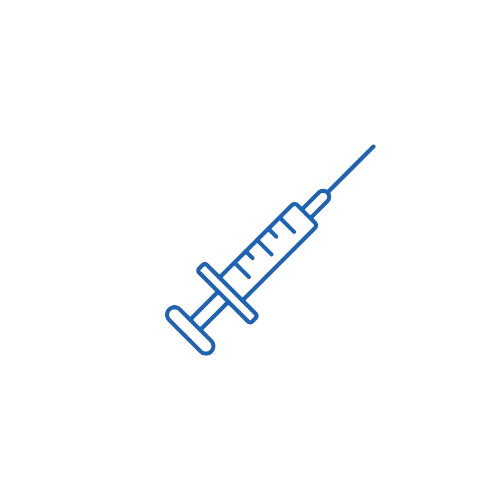Oxytocin
Allopathic
Medicines List
All MedicineIndications
Approved Indications:
Obstetric Use:
- Induction of labor: In women with medical indications (e.g., preeclampsia, post-term pregnancy, PROM).
- Augmentation of labor: In cases of uterine inertia or protracted labor.
- Active management of the third stage of labor: To promote uterine contraction and reduce blood loss.
- Postpartum hemorrhage (PPH): Prevention and treatment due to uterine atony.
- Cesarean section: To stimulate uterine contraction after delivery of the fetus.
- Management of incomplete, inevitable, or missed abortion (early gestation).
Off-label/Clinically Accepted Uses:
- Adjunct to facilitate milk let-down in selected cases of lactation failure (rare, via nasal route – not commonly used now).
Dosage & Administration
Labor Induction or Augmentation:
- IV infusion:
- Initial: 0.5–1 milliunits/minute.
- Increase by 1–2 milliunits/min every 15–60 minutes.
- Usual maximum: 20 milliunits/min (may vary based on protocol).
- Administer via infusion pump with continuous fetal and uterine monitoring.
Postpartum Hemorrhage (PPH):
- Prevention:
- 10 IU IM after delivery of the anterior shoulder or placenta.
- Treatment:
- 10–40 IU in 1,000 mL normal saline or lactated Ringer’s, IV infusion at rate required to control uterine atony.
Cesarean Section:
- 5 IU IV slowly after delivery; may be followed by infusion if needed.
Incomplete/Missed Abortion:
- 5–10 IU IM or IV bolus.
- Or continuous IV infusion of 10–20 IU in 500 mL saline at 20–40 drops/min.
Pediatrics:
- Not indicated for pediatric use.
Elderly:
- Not applicable.
Renal/Hepatic Impairment:
- No dose adjustment needed, but monitor for fluid overload and electrolyte imbalance.
Mechanism of Action (MOA)
Oxytocin is a naturally occurring nonapeptide hormone that binds to oxytocin receptors on uterine smooth muscle, activating phospholipase C via G-protein coupling. This leads to increased intracellular calcium, causing rhythmic uterine contractions. At the mammary gland, oxytocin causes contraction of myoepithelial cells, aiding in milk ejection. Oxytocin also has antidiuretic effects due to its structural similarity to vasopressin.
Pharmacokinetics
- Absorption: Rapid onset after IV (within 1 minute) or IM (within 3–5 minutes) administration.
- Distribution: Small volume of distribution; confined to extracellular space.
- Protein Binding: Approximately 30%.
- Metabolism: Rapidly degraded by oxytocinase in the liver, kidney, and plasma.
- Half-life: 1 to 6 minutes.
- Excretion: Primarily via kidneys as inactive metabolites.
- Onset of Action: Almost immediate with IV, 3–5 minutes with IM.
- Duration: Short; effects last ~30 minutes after IM dose.
Pregnancy Category & Lactation
- Pregnancy: Category X (Not to be used for elective induction of labor without medical indication). Safe when medically indicated and properly monitored.
- Lactation: Safe. It facilitates milk ejection. Very low levels in breast milk and no known adverse effects on the infant.
Therapeutic Class
- Therapeutic Class: Uterotonic Agent
- Subclass: Posterior Pituitary Hormone Analog
Contraindications
- Hypersensitivity to oxytocin or formulation components.
- Cephalopelvic disproportion.
- Fetal distress without immediate delivery.
- Malpresentation (e.g., transverse lie).
- Placenta previa or vasa previa.
- Previous uterine rupture or high risk of rupture.
- Active genital herpes.
- Hypertonic uterine patterns.
- Severe cardiovascular disease.
Warnings & Precautions
- Uterine hyperstimulation may lead to uterine rupture, fetal distress, or death.
- Water intoxication and hyponatremia may occur with high-dose, prolonged infusion due to antidiuretic effect.
- Fetal monitoring is essential during labor induction or augmentation.
- Use cautiously in women with renal, cardiac, or hepatic impairment.
- Avoid rapid IV bolus due to risk of hypotension.
Side Effects
Maternal:
- Uterine hypertonicity, rupture (rare but serious).
- Nausea, vomiting.
- Hypotension, tachycardia, arrhythmias.
- Headache, flushing.
- Water intoxication, hyponatremia.
- Postpartum hemorrhage due to uterine fatigue.
Fetal/Neonatal:
- Fetal distress (due to uterine overcontraction).
- Neonatal jaundice.
- Retinal hemorrhage.
- Low Apgar scores.
- Neonatal hypoxia or death in cases of overdose.
Drug Interactions
- Prostaglandins (e.g., misoprostol): Potentiate uterine contractions – use with caution.
- Inhalational anesthetics (e.g., cyclopropane): May cause hypotension, bradycardia, arrhythmias.
- Vasoconstrictors (e.g., methylergonovine): Increased risk of hypertension.
- Water-retaining drugs (e.g., vasopressin): Increased risk of water intoxication.
- No known CYP450 involvement.
Recent Updates or Guidelines
- WHO, FIGO, and NICE reaffirm oxytocin as the first-line agent for prevention and treatment of postpartum hemorrhage.
- WHO recommends 10 IU IM or IV for PPH prevention during active management of third stage of labor.
- Increasing attention to oxytocin cold chain management in low-resource settings.
- Oxytocin remains a core medicine on the WHO Essential Medicines List.
Storage Conditions
- Temperature: Store between 2°C and 8°C (refrigerated).
- Do not freeze.
- Protect from light.
- If removed from refrigeration, stable for up to 30 days at ≤25°C (per manufacturer's stability data).
- Use immediately after opening or as per institutional protocols.
- Discard if solution becomes discolored or contains particulate matter.
